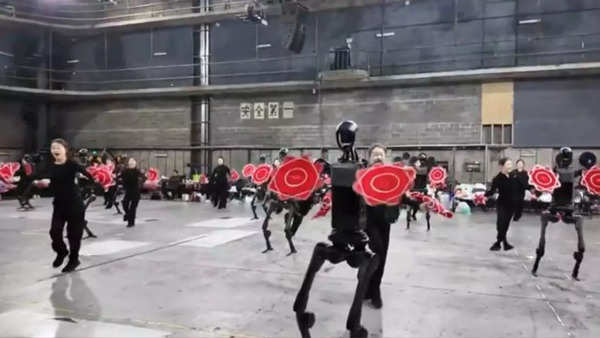Following the buzz around DeepSeek’s AI, China is again grabbing headlines with its dancing robots. The Spring Festival Gala, a major television event in China, is watched by billions of people worldwide. This year, among the musical performances and other acts, a robot dance performance stood out, grabbing global attention. Reportedly, 16 Unitree H1 robots wowed the audiences at the Gala, they also expertly tossed and caught handkerchiefs, a signature move in the traditional Yangko dance, and moved in various dance steps with human performers.
The company behind the robots, Unitree Robotics, took to X and shared, “Unitree H1: Humanoid Robot Makes Its Debut at the Spring Festival Gala 🥰 Hello everyone, let me introduce myself again. I am Unitree H1 “Fuxi”. I am now a comedian at the Spring Festival Gala, hoping to bring joy to everyone. Let’s push boundaries every day and shape the future together.”
Unitree H1: Humanoid Robot Makes Its Debut at the Spring Festival Gala 🥰
Hello everyone, let me introduce myself again. I am Unitree H1 “Fuxi”.
I am now a comedian at the Spring Festival Gala, hoping to bring joy to everyone.
Let’s push boundaries every day and shape the future… pic.twitter.com/MsFuIo6BL0— Unitree (@UnitreeRobotics) January 28, 2025
Why does the dance look so disturbing?
Many might praise this dance and talk about how humans are developing their skills in the field of technology and artificial intelligence. It also gave many viewers a sense of unease and also makes us think why does this spectacle of dancing robots feel a little disturbing?
On one hand, the robot dance is a remarkable achievement of human engineering. It’s fascinating to see robots perform complex movements with such precision. As per Business Standard, these robots underwent three months of AI-driven training to perfect their dance moves. They use laser SLAM technology for accurate positioning, adjusting to the stage, and changes in formation. The robots stand 1.8 meters tall and weigh 47 kilograms, showcasing China’s advancements in AI and robotics.
Loss of human expression?
However, there’s a sense of unease. Some argue that when robots take over an art form like dance, it strips away human emotion and meaning. Dance is often an expression of human feelings, and transferring it to emotionless machines can feel hollow. Another reason for the discomfort might be the appearance of the robots. Their featureless faces can be unsettling. Yet again making them look too human-like might be even more disturbing.

Netizens react
On a Reddit page r/Damnthatsinteresting, users didn’t hold back in expressing their thoughts. One user shared “Grandma is utterly confused and my mom is outraged, saying that this completely shatters the meaning of the celebration and that she now has even fewer reasons to watch at all.”
Another commenter joked, saying, “Matter of time till they put cute faces on them and K-pop will be replaced.” A user sarcastically wrote, “Thank god I don’t have to do my own dancing anymore. Can I also get a robot to do my laughing and hugging?” A user concerned about replacing human creativity with technology, “Can we please stop replacing art and creativity with technology/AI and instead use it for tasks that make people’s lives easier like taking out the trash, etc.? “
These comments show a whole range of emotions, from confusion to outrage and concern about the role of technology in art. It also raises questions about robots doing art and whether we’ll lose something special about being human. Lots of us love dancing, singing, or painting, even if it’s just a hobby or a way to let off our emotions and expressions. But life gets in the way, especially with work and responsibilities. So, watching robots do things we wish we could might feel a bit unsettling. It’s like they’re living out our dreams while we’re stuck at our desks. Makes you think, doesn’t it?


